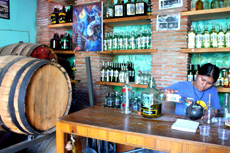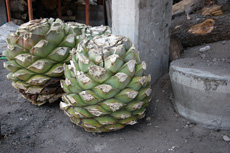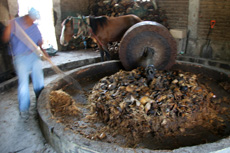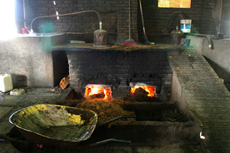Research into Mezcal proves to be interesting and highly rewarding
When traveling it is necessary to leave behind all that I am used to and learn to accept the treasures of the region that I am in. The state of the Mexican wine industry can at best be described as deplorable and at worst… well I’d rather not go there. Combine that with bland, insipid, mass-produced beer and becoming a teetotaler starts to look like an attractive option.
 |
|
The tasting room at the Union of Palenqueros |
Unfortunately for the budding teetotaler there is the siren call of Mezcal, the locally produced liquor that embodies all the qualities of a proper homage to the gods of spirits. Mezcal is an ancient distilled spirit made from the agave plant that used to be reserved for consumption by the nobility and high priests. The plants are either cultivated in an arid mountain climate, or as in the case of Tobalá, found growing wild in the mountains. The leaves are removed, leaving only the heart of the plant or piña.
 |
|
Agave piñas ready for processing. |
The piñas are then roasted in a conical outdoor oven or palenque for several days and then chopped up. The resultant bits are brought inside where a mule powered mill is used to create a mash for the fermentation. A small amount of water is added to the mash and the mixture is fermented in large open barrels for two to fifteen days.
After fermentation the mash is double-distilled in wood fired stills, or as in the case of Pechuga, triple distilled. The spirit is then aged in wooden barrels for up to twelve years as in the case of Añejo or consumed immediately as in the case of Mezcal Blanco. Sometimes a worm or gusano is added for a bit of pizazz and flavor. Surprisingly, eating a Mezcal infused gusano tastes exactly what you would think a Mezcal infused gusano would taste like.
 |
 |
|
Grinding the piñas |
Wood fired still |
The tiendas of large producer Beneva with their nubile young female hostesses, are hard to miss in the city of Oaxaca. The “Starbucks Coffee” of mezcal, they produce an inoffensive and good quality Añejo. But just like Starbucks Coffee, the discerning consumer will soon realize that there is something better over the horizon – small production artisanal Mezcal. The subject can take a lifetime of study, but some good producers we discovered were Real Minero (available at the Pochote organic market) and El Rey Zapoteco. However, the best mezcal we found comes from a small collective of eight farmers called the Union of Palenqueros, located at 510 Abasolo in a building badly in need of repair. Their Añejo de 12 años is a marvel.
A small artisanal producer, like the Union of Palenqueros, produces a wide array of mezcal:
| Blanco | Aged for a brief period of time and very strong in taste. |
| Reposado | Aged for a up to a year, it can be earthy and strong. |
| Gusano | A worm is added to the spirit for flavor. The popular brand, Gusano Rojo, is of extremely poor quality and should not be used as a gauge for this or any other type of Mescal. |
| Añejo | Usually aged for three years or more. Smooth and earthy, the best varieties can be amazingly complex with earth, tobacco, vanilla overtones. My personal favorite. |
| Tobala | Made from wild Maguey plants, it has a distinct spirit taste, a little reminiscent of paint solvent. Prized by many for that same reason. |
| Pechuga | Traditionally made by hanging a chicken or turkey breast in the still or by hanging a slab of maguey. Triple distilled and distinctly fruity. |
| Punta | Made from the first products of the distillation punta is fruity and packs a wallop. Normally it exceeds 140 proof! |
| de Olla | Made by the traditional process of using clay pots for distillation, it has a characteristic smoothness that cannot be achieved by modern equipment. |
Good post, I’m tasting a bit of the Union of Palenqueros product as Ada and I read this.
Fred –
So would that be the marvelous Añejo de 12 años? Neena and I are enjoying our alacranes made with a Mezcal we picked up at a fabrica outside Tlacoulula. They put a gusano in their Anejo – how strange! We’ve made that the mezcal for alacranes at the moment.
Did the Palenqueroes include some of their sal de guisano for you? I ran out of my supply and have been forced to use the Real Minero sal!
O the horror! No sal de guisano? We, fortunately, have plenty for the time being. But one sad day it will be gone and we will be as savages wandering in the wilderness.
When did you visit a Mezcal facility to get those pictures?
Now, that you have done such a good job with the mezcal research, will you move on to other substances? Peyotl and mescaline are local, too, I believe.
Fred,
After we dropped you off at the airport we visited it on the way back from the ruins at Mitla. Matatlan, however, seems to be ground zero for Mezcal production – the entire town is just Mezcal fabricas.
Jerzy,
Peyote sounds a bit ugly – what with all the throwing up and all. Don’t know much about mescaline. I try to restrict my illegal drug consumption to countries that have clean prisons!
Wow, you guys are very much the epicurean travelers. Pleasure to read your travel-blog 🙂
Vinay,
I guess you can say we are passionate about food an drink, but our waistlines SHOW it!
This post makes me want to experiment with making pineapple or honey wine at home! Ordering my mule on amazon right away..